Of all of the things you can do, learning to cook and cooking most of your meals at home is probably one of the best ways to improve your financial future. Meals out are a huge expense, not to mention the sodium content and calories. If you just eat in most meals, limiting your eating out to about a meal a week, and invest what you would have spent at the restaurants you can easily retire a multi-millionaire just from the savings.
Unfortunately, with the push to the two-earner household of the 1960’s many twenty and thirty-somethings today have no idea how to cook. All of their meals were at restaurants or they grew up on pre-processed, frozen meals. Many people also feel that they don’t have time for cooking at home. For this reason, I thought I’d share some of the basics for learning to cook and some tips to save time that we have learned and that have served us well. If you plan it right, you could actually spend less time cooking than you spent driving to and then waiting at restaurants to eat.
The Ingredients
The first step in starting to cook at home is to gather the basic foods you’ll need. While some recipes call for special ingredients, there are some basic you’ll want to keep on hand since many recipes will call for one or more of them. Here is a list of supplies that we normally have on-hand. While the initial expense may be fairly high (probably $300 or so to initially stock the pantry), with these ingredients you’ll be able to cook a wide variety of standard American meals. (If you’re cooking Asian, South American food, or food from some other culture, there will be a slightly different list.) Also, once you have bought the initial supply, many ingredients will last for a long time and be used in several meals. There are always some fancy ingredients beyond this list that you may find in recipes, but those can be bought as needed. In fact, you may be able to leave many of those ingredients out (since the left-over will just sit on your shelf for years anyway).
Here are the basic ingredients you should always keep in stock:
Basic foods: Bread, potatoes, eggs, bacon, milk, flour (unbleached if possible), cheddar cheese, carrots, celery, fruit (apples, pears, oranges, etc…), lettuce, greens (spinach, mustard, collard, chard, or turnip greens), onions, butter or margarine, cooking oil, olive oil, vinegar, bread crumbs, shortening, baking powder, baking soda, sugar, frozen vegetables, canned vegetables and beans (green beans, corn, tomatoes, cream soups (mushroom, celery, or chicken), kidney beans, great northern beans). pancake syrup, jams and jellies, corn meal, and rice.
Meats: Each shopping period you would buy the meats you would use (for example, chicken, pork chops, steaks, ground beef, and fish).
Spices: Salt, pepper, garlic power, paprika, ground dried mustard, bay leaves, basil, thyme, cinnamon, nutmeg, cumin, and chili powder.
Note we don’t tend to use a lot of the short-cuts like pre-made biscuits, pie crusts, and pizza crusts. These are actually fairly easy to make with just flour, salt, shortening, and baking powder, but having them would save a little time (in exchange for a little extra expense). Pancakes are really easy from scratch and a lot better (the secret is to whip the snot out of the eggs with a whisk). We also don’t tend to use a lot of the spice mixtures like Italian Seasoning, but these can save a little time looking for spices.
Tools of the Trade
In addition to a stocked pantry, you’ll need a set of basic tools. There are always a lot of things out there you could buy. A lot of gadgets advertise that they will make cooking a lot easier, but the truth is that most of those gadgets only add value if you are cooking in bulk. For example, if you are making gallons of salsa, it makes sense to pull out the Cuisinart. If you are just cutting up an onion, however, you’ll spend ten times as much time dragging the thing out and then washing it and putting it away than you will actually spend cutting the onion. You’ll find that most of the time it is just easier to pull out a knife.
Here are the items that a well-stocked kitchen should have:
- 1 set of mixing bowls (small, medium, and large) example: Pyrex Prepware 3-Piece Glass Mixing Bowl Set
- 2 glass measuring cups – 1 cup and 2 cup

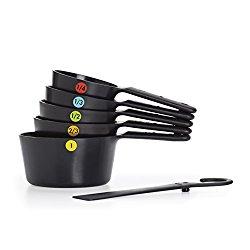
Wet and dry measuring cups
- 1 set of plastic dry measuring cups (1/4 cup, 1/3 cup, 1/2 cup, 1 cup)
- 1 set of measuring spoons (1/4 tsp. 1/2 tsp. 1 tsp. 1 tbsp)
- 2 spatulas, two large spoons (one solid, one slotted), a whisk, 2 rubber spatulas, 1 two-pronged fork, 1 set of tongs
example tool set: Gibson Home 99202.20 Total 20 Piece Kitchen Tool/Gadget Prepare & Serve Combo Set, Black
- 2 frying pans (cast iron is best), 4 sauce pans (small, medium, large, and extra-large) with lids

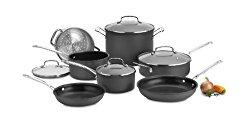
Example cast iron skillet and set of pots and pans
- 2 baking sheets
- 1 colander
- 1 set of knives (1 chef knife and 1 paring knife, perhaps a bread knife) example: Cuisinart 15-Piece Stainless Steel Hollow Handle Block Set, C77SS-15PK
- 1 set of wooden spoons
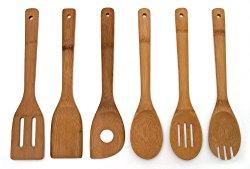
An example set of spoons
- 1 grater
- 1 set of pot holders
- 2 cutting boards (one for meat, one for everything else)
- 1 set of cake pans (round)
- 1 9×13 pan
- 1 9×9 pan
- 1 muffin pan
These are nice to have, but are used less often:
- A blender, a salad spinner, a waffle maker, a toaster over, a crock pot.
- A pastry cutter
- An extra spatula (never have enough)
- An extra small sauce pan
- A ladle
- A bread pan
- Apple corer (metal)
- Egg slicer
- Food processor
- Hand mixer
Saving Time
Unfortunately, a lot of people who try to start cooking get a recipe that is too complicated, get every pan in the house dirty, then decide to go back to take out and frozen dinners. Cooking does not need to be complicated and time-consuming, especially for every day meals. You might want to spend a few hours in the kitchen and put out all of the gadgets for a special meal, but not when you just want something to eat after work.
Here are a few tips that people who cook regularly use to save time and make cooking doable with a busy schedule:
1. Don’t try to cook like someone from the Food Network. Also, forget those elaborate recipes you find in the cooking magazines that require umpteen ingredients. Just learn how to make the basic meals (chicken, pork chops, hamburgers, fish, spaghetti, stew, etc…).
2. Buy a general cookbook that will give you the basics. Good ones are The Joy of Cooking and Betty Crocker.
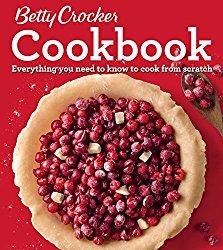
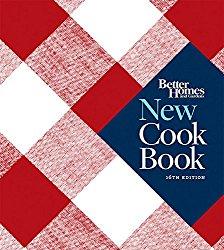
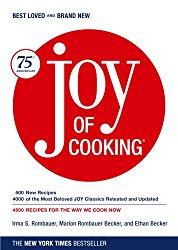
Pick up one of these great basic cookbooks
3. It takes the same amount of time to make six portions as four. Cook a little extra and you’ll have a lunch that is the envy of your office the next day.
4. Make a big salad and keep it in your refrigerator covered in plastic wrap. Only put in lettuce, carrots, and celery. Add things like tomatoes (that don’t do well in the refrigerator) during the meal to each portion. You can also make a big portion of soup and heat some up for meals during the week.
5. Many meals freeze well. Make a double portion one week, then freeze and reheat the next week. Be sure to write the date you made it and plan to eat it within a month or so.
6. Plan you meals. Write what you plan to eat during the week or next two weeks then make your grocery list from the ingredients needed. Freeze any meats you won’t use for at least three days. The day before the meal, put the meat for the next meal in the refrigerator so that it will be defrosted and ready to go (it will taste better if not defrosted in the microwave too).
7. The crock pot is your friend. All of your soups and stews, and even things like ribs and chicken can be made in the crock pot. You can even put them together the night before, put it in the refrigerator, then start it on low in the morning before work. When you get home, you’ll have a hot meal waiting.
Follow me on Twitter to get news about new articles and find out what I’m investing in. @SmallIvy_SI
Disclaimer: This blog is not meant to give financial planning or tax advice. It gives general information on investment strategy, picking stocks, and generally managing money to build wealth. It is not a solicitation to buy or sell stocks or any security. Financial planning advice should be sought from a certified financial planner, which the author is not. Tax advice should be sought from a CPA. All investments involve risk and the reader as urged to consider risks carefully and seek the advice of experts if needed before investing.
Advertisements